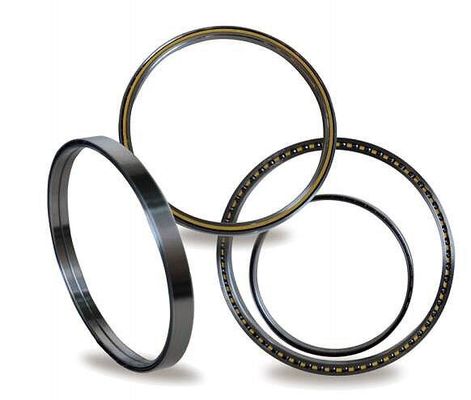Features of the Crossed Roller Ring

Structure and Features
With the Cross-Roller Ring, cylindrical rollers are arranged with each roller perpendicular to the adjacent roller, in a 90° V groove, separated from each other by a spacer retainer. This design allows just one bearing to receive loads in all directions including radial, axial and moment loads. Since the Cross-Roller Ring achieves high rigidity despite the minimum possible dimensions of the inner and outer rings, it is optimal for applications such as joints and swiveling units of industrial robots, swiveling tables of machining centers, rotary units of manipulators, precision rotary tables, medical equipment, measuring instruments and IC manufacturing machines.
High Rotation Accuracy
The spacer retainer fitting among cross-arrayed rollers prevents rollers from skewing and the rotational torque from increasing due to friction between rollers. Unlike conventional types using steel sheet retainers, the Cross-Roller Ring does not cause unilateral contact of roller or seize. Thus, even under a preload, the Cross-Roller Ring provides stable rotation.
Since the inner and outer rings are designed to be separable, the bearing clearance can be adjusted.
In addition, a preload can be applied. These features enable accurate rotation.
Easy Handling
The inner and outer rings, which are separable, are secured to the Cross-Roller Ring body after being installed with rollers and spacer retainers in order to prevent the rings from separating from each other. Thus, it is easy to handle the rings when installing the Cross-Roller Ring.
Skewing Prevention
The spacer retainer keeps rollers in their proper position, thereby preventing them from skewing(tilted rollers). This eliminates friction between rollers, and therefore secures a stable rotational torque.
Increased Rigidity (Three to Four Times Greater than the Conventional Type) Unlike the thin angular ball bearings installed in double rows, the cross array of rollers allows a single Cross-Roller Ring unit to receive loads in all directions, increasing the rigidity to three to four times greater than the conventional type.

Large Load Capacity
(1) Compared with conventional steel sheet retainers, the spacer retainer allows a longer effective
contact length of each roller, thus signifi cantly increasing the load capacity. The spacer retainer guides rollers by supporting them over the entire length of each roller, whereas the conventional type of retainer supports them only at a point at the center of each roller. Such one-point contact cannot suffi ciently prevent skewing.

(2) In conventional types, the loaded areas are asymmetrical between the outer ring and the inner ring sides around the roller longitudinal axis. The greater the applied load is, the greater the moment becomes, leading end-face contact to occur. This causes frictional resistance, which hinders smooth rotation and quickens wear.

Types of the Cross-Roller Ring
Types and Features
Model RU (Integrated Inner/Outer Ring Type)
Since holes are drilled for mounting, the need for a presser fl ange and a housing is eliminated. Also, owing to the integrated inner/outer ring type stryucture with washer, there is almost no effect from installation on performance, allowing stable rotational accuracy and torque to be obtained. Can be used for both outer and inner ring rotation.

Model RB (Separable Outer Ring Type for Inner Ring Rotation)
Cross-Roller Ring basic type, with a separable outer ring, and an inner ring integrated with the main body.It is used in locations where the rotational accuracy of the inner ring is required. It is used, for example, in the swivel portions of index tables of machine tools.

Model RE (Two-piece Inner Ring Type for Outer Ring Rotation)
Main dimensions are the same as model RB. This model is used in locations where the rotational accuracy of the outer ring is required.

Model RA (Separable Outer Ring Type for Inner Ring Rotation)
A compact type similar to model RB with the thinnest possible inner and outer rings. Optimal for locations requiring a light-weight and compact design such as the swivel portions of robots and manipulators.

Selecting a Cross-Roller Ring
The following diagram shows a typical procedure for selecting a Cross-Roller Ring.

Fit
Fitting of Models RU
Fitting for model RU is typically not required. However, for fi tting requiring positioning accuracy, h7 and H7 are recommended.
Fitting of Models RB, RE and RA
For the fi tting of models RB, RE and RA, we recommend using the combinations indicated in Table1 .
Table1 Fitting of Models RB, RE and RA

Fitting of the USP-grade
For the fi tting of the USP-grade series of models RB and RE, we recommend using the combinations
indicated in Table2 .
Table2 Fitting of the USP-grade

Fitting of Model RA-C
Since model RA-C is thin and its outer ring is split in one position, it is considerably affected by fit.
We recommend measuring the inner and outer diameters of the bearing and applying a slight interference
fit to match the diameters.
Example of Assembly
Fig.2 and Fig.3 show examples of installing the Cross-Roller Ring.

Model Number Coding
Model number confi gurations differ depending on the model features. Refer to the corresponding
sample model number confi guration.
Cross roller rings with integrated inner and outer rings.
Model RU

Models RB, RE, RA and RA-C

Application:





 Your message must be between 20-3,000 characters!
Your message must be between 20-3,000 characters! Please check your E-mail!
Please check your E-mail!  Your message must be between 20-3,000 characters!
Your message must be between 20-3,000 characters! Please check your E-mail!
Please check your E-mail! 















